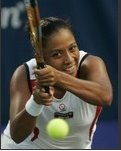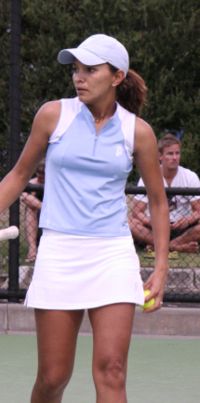PART I - The Beginning
PART II
THE EMERGENCE OF A BLACK CHAMPION
Role models within black communities were also easy to find during the forty’s and fifty’s. Segregation prevented successful Blacks from moving into the white, suburban communities, so “inner-city” children resided alongside doctors, lawyers and other legitimate businesspeople. Bandleader Duke Ellington, lightweight boxing champion Beau Jack, New York Giants baseball player Hank Thompson and other world-class entertainers lived within one block of my family’s New York City apartment.

In 1940, Donald Budge, the finest white player in America, took it upon himself to go into Harlem, in New York City, to play an exhibition match at the Black owned Cosmopolitan Tennis Club. He played against the top black player of the day, Jimmy McDaniel. The fact that McDaniel lost the match handily is no more than a footnote to the significance of Budge's appearance. It was the first time that a black player was able to test his skills against a white player; to gauge his strokes, strategy and knowledge of the sport against the best in the world. A white player had taken a stand in support of equal opportunity. Players, you see, have never been the problem; it has always been the administration struggling to break with tradition.
In 1946, a crude, street-tough, 19 year-old named Althea Gibson attracted the attention of two physicians, Dr. Hubert Eaton and Dr. R. Walter Johnson. An arrogant teenager, Althea lost in the finals of the ATA Women’s National Championships but her strength and athletic prowess was undeniable. She won the junior national titles in 1944 & 1945 and now, in her first year playing in the adult division, immediately became a serious challenge to the best ATA women players. By 1949, more than 30 years after the formation of the ATA, Althea began to challenge the collective

imagination of the Black tennis community. She was seen as one outstanding player who had the potential to break the color barrier. But, there were problems! Blacks understood that a flaw attributed to one colored athlete would be attributed to all people of color. And Althea had flaws! She had not graduated from high school and her social graces were severely lacking. To Althea, competition was WAR! A loss would see her head straight for the locker room; no handshake, no “nice-match”, no smiles or other generally accepted niceties typically associated with tennis. These “flaws” would need to be corrected lest those that would follow her be burdened with her baggage. In fact, it was generally believed that if her “flaws” weren’t repaired, no one would be allowed to follow her. At the urging of world boxing champion Sugar Ray Robinson, Althea moved to Wilmington, NC to live with Dr. Eaton and his family as she studied to secure a high school diploma. This proximity to Dr. Eaton would also provide an opportunity to instill the manners and perspective that she would need to succeed. Summers had been well spent in training at Dr. Johnson’s home in Lynchburg, VA. By this time, Althea had become the class-of-the-field. She began to raise national awareness when, as a high school sophomore, she won 9 ATA tournaments without a loss. The overall strategy worked and in 1949, at the age of 22, Althea received her high school diploma and her graduation ring (paid for by welter-weight champion of the world, Sugar Ray Robinson).
The recognition that she received would pressure the USLTA to accept her entries into the Eastern Indoors and the National Indoors in 1949. She reached the quarterfinals of both events and now hoped to play the grass court circuit that led up to the USLTA National Championships at Forest Hills, New York. (In the pre-U.S. Open era, the U.S. National Championships were held on grass courts not far from today’s National Tennis Center in Flushing Meadows). But, the USLTA had not yet decided if it would allow this “colored” woman to be the first of her race to play in America’s most prestigious tournament.
Racial prejudice, to many people of color, is a very confusing experience. Many people wondered how Pancho Segura, a man of color from Guayaquil, Equador, stricken with Rickets during childhood, was so easily welcomed into this lily-white environment. He was considerably darker in color than Althea, yet his acceptance never questioned. His bout with rickets caused his legs to be severely bowed and he was quite pigeon-toed. In fact, Billy Talbert and Segura, ranked number one and three in America respectively, represented the USLTA in an exhibition in Harlem in 1945. Talbert disposed of Jimmy McDaniels 6-2, 6-1, while Pancho beat Lloyd Scott, 6-2, 6-2. Pancho thrilled the Cosmopolitan crowds with his two fisted (baseball-like) style. In spite of his infirmities, Pancho was quite a good player. His earliest success came as a student at the University of Miami, where he won the NCAA singles championships three times in a row (from 1943 to 1945), a feat not matched in the twentieth century. I mention this only as a point of interest because Althea held no animosity towards Pancho; or anyone else for that matter. His unconditional acceptance into the white, inner-circle, indeed his affiliation with the USLTA was, and remains, somewhat of a curiosity.
Now, a nearly two decades after Don Budge stood his ground and broke with tradition, one of America’s finest women players would stand up for Althea. Alice Marble, one of the finest white players in America would challenge the administration to allow her to compete. She wrote an impassioned letter to the American Lawn Tennis Magazine in 1950 that was primarily responsible for Althea’s ability to play in and win Wimbledon and the U.S. National Titles in 1957 & 58.
This letter, given the time, context and author eloquently exposed the prejudice more clearly as anything before or since.
The letter read:
“On my current lecture tours, the question I am most frequently expected to answer is no longer: What do you think of Gussie’s panties? For every individual who still cares whether Gussie Moran has lace on her drawers, there are three who want to know if Althea Gibson will be permitted to play in the Nationals this year. Not being privy to the sentiments of the USLTA committee, I couldn’t answer their questions, but I came back to New York determined to find out. When I directed the question at a committee member of long standing, his answer, tacitly given, was in the negative. Unless something within the realm of the supernatural occurs, Miss Gibson will not be permitted to play in the Nationals.
He said nothing of the sort, of course. The attitude of the committee will be that Miss Gibson has not sufficiently proven herself. True enough, she was a finalist in the National Indoors, the gentleman admitted – but didn’t I think the field was awfully poor? I did not. It is my opinion that Miss Gibson performed beautifully under the circumstances. Considering how little play she has had in top competition, her win over a seasoned veteran like Midge Buck seems to me a real triumph. Nevertheless the committee, according to this member, insists that in order to qualify for the Nationals, Miss Gibson must also make a strong showing in the major eastern tournaments to be played between now and the date set for the big do at Forest Hills. Most of these major tournaments – Orange, East Hampton, Essex, etc, - are invitational, of course. If she is not invited to participate in them, as my committee member freely predicted, then she obviously will not be able to prove anything at all, and it will be the reluctant duty of the committee to reject her entry at Forest Hills. Miss Gibson is over a very cunningly wrought barrel, and I can only hope to loosen a few of its staves with one lone opinion.
I think it’s time we faced a few facts. If tennis is a game for ladies and gentlemen, it’s also time we acted a little more like gentle people and less like sanctimonious hypocrites. If there is anything left in the name of sportsmanship, it’s more than time f\to display what it means to us. If Althea Gibson represents a challenge to the present crop of women players, it’s only fair that they should meet that challenge on the courts, where tennis is played. I know those girls, and I can’t think of one who would refuse to meet Miss Gibson in competition. She might be soundly beaten for a while – but she has a much better chance on the courts than in the inner sanctum of the committee, where a different kind of game is played.” In closing, Miss Marble wrote: “I am beating no drums for Miss Gibson as a player of outstanding quality. As I said, I have seen her only in the National Indoors, where she obviously did play her best and was still able to display some lovely shots. To me, she is a fellow tennis player and, as such, deserving of the chance I had to prove myself. I’ve never met Miss Gibson but, to me, she is a fellow human being to whom equal privileges ought to be extended. Speaking for myself, I will be glad to help Althea Gibson in any way I can. If I can improve her game or merely give her the benefit of my own experiences, as I have many other young players, I’ll do that. If I can give her an iota more of confidence by rooting my heart out from the gallery, she can take my ford for it: I’ll be there.”
This impassioned letter was singularly responsible for Althea’s acceptance into several qualifying tournaments and for her admittance into the 1950 U.S Nationals. Althea easily won her first

round match and lost in the second round of the Nationals to Louise Brough, a three- time Wimbledon Champion and the 1947 United States Champion. The 9-7 third set loss to Brough put everyone on notice that a serious, new contender had arrived. Althea had broken the color barrier! She went on to win the French Open singles and doubles and the Wimbledon doubles titles in 1956. She became the undisputed best player in the world by winning Wimbledon and the U.S National singles titles in 1957 and 1958. Althea retired to pursue a career in professional golf and as an entertainer, but before leaving this page I want to say to Althea Gibson (whom I have known, admired, played tennis with and whom I have called a friend since I was a kid) “Althea, you did us proud!”

Althea was also a celebrity of world-class proportions in her adopted hometown of New York City. She became a product spokesperson for the Ward Baking Company and (At left) was greeted on the steps of City Hall by Mayor Robert Wagner. Like Jackie Robinson before her, Althea had finally become “somebody.” She won Wimbledon and the U.S. Open in 1957 and 1958 – something that no Black woman has ever done before….or since.
The author, Bob Davis, currently owns and operates Coastal Tennis and Sports, LLC in Bradenton, Florida.
Read the rest of this post...........
 NEW YORK — Serena Williams has pulled out of an exhibition at Madison Square Garden because of a left leg injury.
NEW YORK — Serena Williams has pulled out of an exhibition at Madison Square Garden because of a left leg injury.




































































































![Validate my Atom 1.0 feed [Valid Atom 1.0]](valid-atom.png)
